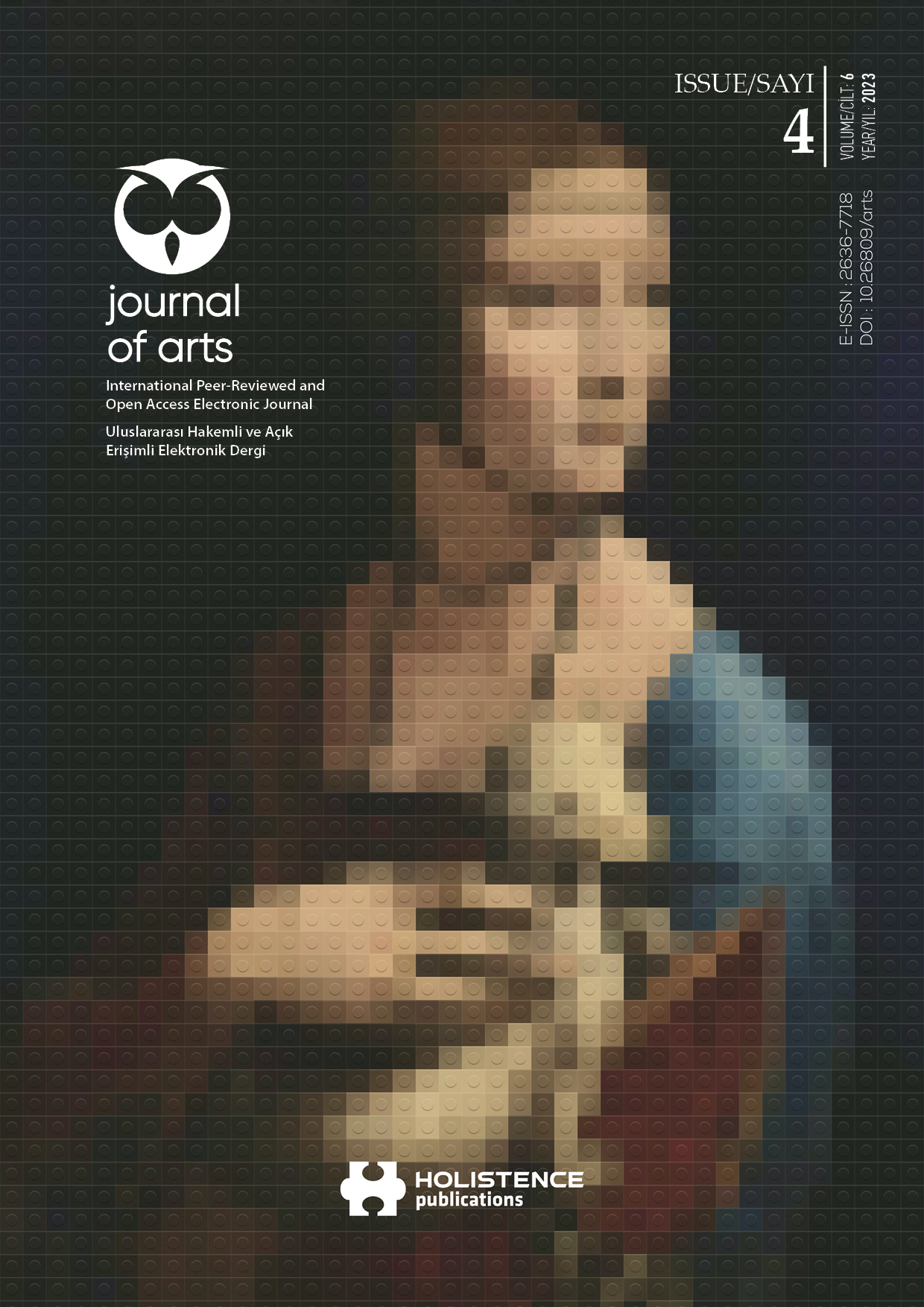An evaluation on the art of engraving and its contribution to art education
DOI:
https://doi.org/10.31566/arts.2183Keywords:
Engraving, Intaglio Printing, Relief Printing, Art, Art EducationAbstract
Art is a means of communication between societies from past to present, which has existed for ages and will exist in the future. Artists produce art in the light of the conditions and needs they experience in order to express their feelings and thoughts. Therefore, their views and pursuits towards art, beauty and aesthetics have also differed from each other within their life cycles. Due to their individual talents and interests, artists have chosen different techniques and materials in their production processes. As an effective means of artistic expression that includes different applications and techniques, engraving, the art of engraved painting (intaglio, relief printing), and the contributions of engraving to art education have been determined as the research subject of this article. When evaluated with all its differences, engraving is an independent visual plastic art although it stands close to painting and graphic arts. Engraving has taken place in the life and art adventure of many master artists known in the history of art. An Egyptian seal dating back to 1550 BC is an indication of how the art of engraving (relief printing) has existed in human history as a necessity that emerged in the life cycle of society.
The art of engraving, which has an important place and value in art education as well as in the history of art, contributes greatly to the students’ self-improvement with the practitioners of this art, their applications, their original print works (intaglio, relief printing) and engraving lessons. In art education, engraving lessons support the formation of the foundations of the art of painting in students by enabling experiments with different applications as well as analysis and composition on elements such as point, line, stain, light-dark, light-shadow, color, space, perspective.
Downloads
References
ARNASON, H.H, (1986) History of Modern Art Painting Sculpture Architecture, Expresyonism in Germany, New York:Harry N.Abrams
GOMBRICH, E. H. (1986) Sanatın Öyküsü. Çeviren: B.Cömert, İstanbul: Remzi kitabevi
GRABOWSKI, B & FICK, B (1999) Baskı Resim Çevirenler: S.Atay Eskier & A. Ziya Tunç, İzmir: Karakalem Kitabevi Yayınları,
KIRAN, H. (2017). Çağdaş Baskı resim sanatına genel bir bakış. Anadolu üniversitesi Sanat ve tasarım Dergisi, 10,56
RICHARD, L. (1984), Çevirenler: Beral Madra-Sinem Gürsoy-İlhan Usmanbaş, Ekspresyonizm Ansiklopedisi, İstanbul: Remzi Kitabevi
SAN, İ. (2003).Sanat Eğitimi Kuramları. İstanbul: Ütopya yayınevi, İkinci.Baskı
SOYŞEKERCİ, S. (2018). Goya’nın rüyası: Aklın Uykusu canavarlar üretir. İdil Dergisi, (7),1342
URL-1: “Tokat’ın Antik Comana Potica Kentinde Mısır’ın 18.Hanedanlığına ait mühür bulundu”Arkeonews, (2021) https://arkeonews.com/tokatin-antik-comana-potica-kentinde-misirin-18-hanedanligina-ait-muhur-bulundu/
URL-2: “ Özel tekniklerin kullanıldığı Japon Resim Sanatı Ukiyo-e Üzerinden Japonyanın Red Light’ı” ( 23 Ocak 2018)(1 eylül 2023) https://eksiseyler.com/ozel-tekniklerin-kullanildigi-japon-resim-sanati-ukiyo-e-uzerinden-japonyanin-red-light-i
Görsel Kaynaklar
Resim 1: Mısır 18.Hanedanlığına ait mühür https://arkeonews.com/tokatin-antik-comana-potica-kentinde-misirin-18-hanedanligina-ait-muhur-bulundu/
Resim 2: Doğru İnsanın Cançekişmesi, 1470 Ulm’da resimlenen İyi Ölme sanatı, tahta baskı kitap. Kaynak: Gombrich, E.H.(1986) Sanatın Öyküsü. Çeviren: B. Cömert, İstanbul: Remzi kitabevi, 213
Resim 3: Albrecht Dürer, Cennetten Kovulma, Ağaç baskı, 1510. Kaynak: Grabowski, B & Fick, B (1999) Baskı Resim Çevirenler: S. Eskier & A. Tunç, İzmir: Karakalem Kitabevi Yayınları, 75
Resim 4: Utamaro- “ Japonya’nın Red Light’ı” (Japon tahta baskı). Kaynak: https://eksiseyler.com/ozel-tekniklerin-kullanildigi-japon-resim-sanati-ukiyo-e-uzerinden-japonyanin-red-light-i
Resim 5: “Çığlık”, Edward Munch, 1885. Kaynak: Richard, Lionel, çev: Beral Madra-Sinem Gürsoy-İlhan Usmanbaş, Ekspresyonizm Ansiklopedisi, Remzi Kitabevi, 1984
Resim 6: Erich Heckel, Kendi Portresi, 1917. Kaynak: Richard, L. (1984), Çevirenler: Beral Madra-Sinem Gürsoy-İlhan Usmanbaş, Ekspresyonizm Ansiklopedisi, İstanbul: Remzi Kitabevi, 58
Resim 7: Shongauer, İsa’nın Doğuşu, Oyma Resim, Bakır üzerine soğuk kazı, 1475 dolayları. Kaynak: Gombrich, E. H.(1986) Sanatın Öyküsü. Çeviren: B. Cömert, İstanbul: Remzi kitabevi, 214
Resim 8: Dürer, Adem ve Havva, 1504, Bakır oyma resim. Kaynak: Gombrich, E. H. (1986) Sanatın Öyküsü. Çeviren: B. Cömert, İstanbul: Remzi kitabevi, 267
Resim 9: Rembrandt “İsa’nın Dinsel Öğüdü” Asit oyma, 1652 dolayları. Kaynak: Gombrich, E. H. (1986) Sanatın Öyküsü. Çeviren: B. Cömert, İstanbul: Remzi kitabevi, 335
Resim 10: Francisco de Goya “Aklın uykusu canavarlar yaratır” Aquatint. Kaynak: Grabowski, B & Fick, B (1999) Baskı Resim Çevirenler: S. Atay Eskier & A. Ziya Tunç, İzmir: Karakalem Kitabevi Yayınları, 123
Additional Files
Published
How to Cite
Issue
Section
License
Copyright (c) 2023 Holistence Publications

This work is licensed under a Creative Commons Attribution 4.0 International License.
When the article is accepted for publication in the Journal of Arts, authors transfer all copyright in the article to the Rating Academy Ar-Ge Yazılım Yayıncılık Eğitim Danışmanlık ve Organizasyon Ticaret Ltd. Şti.The authors reserve all proprietary right other than copyright, such as patent rights.
Everyone who is listed as an author in this article should have made a substantial, direct, intellectual contribution to the work and should take public responsibility for it.
This paper contains works that have not previously published or not under consideration for publication in other journals.










